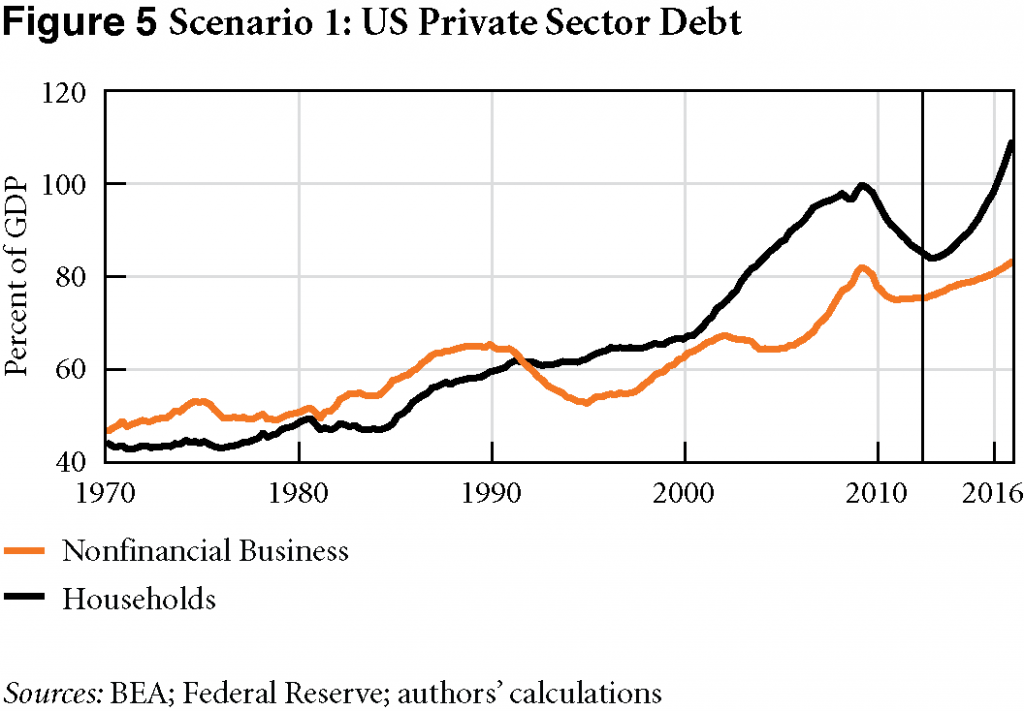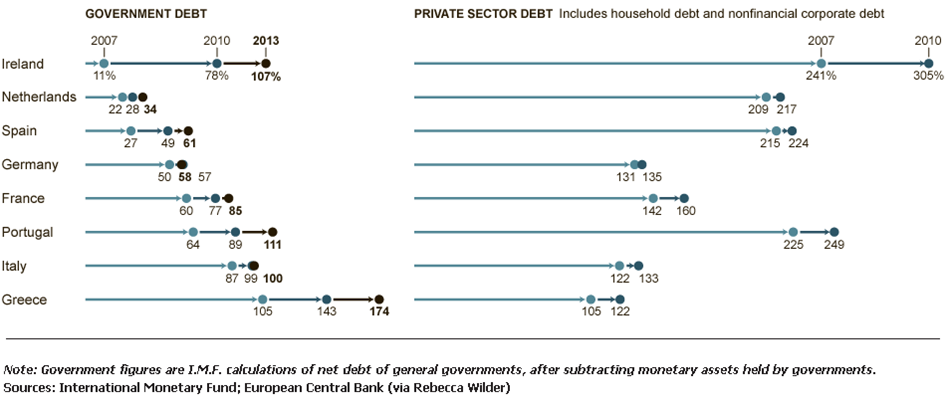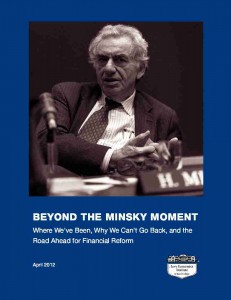Michael Stephens | April 27, 2012
That’s one of the questions the Levy Institute’s latest Strategic Analysis asks as it examines the Congressional Budget Office’s projections for growth and employment in the context of tighter and tighter government budgets. At the federal level alone we’re facing a well-publicized “fiscal cliff” in 2013, featuring large scheduled spending cuts and the expiration of a number of tax cuts.
As Dimitri Papadimitriou, Gennaro Zezza, and Greg Hannsgen note, the CBO “expects real GDP to grow by 2.2 percent in 2012 and by only 1 percent in 2013, and to accelerate once most of the fiscal adjustment has taken place, with growth reaching 3.6 percent in 2014 and 4.9 percent in 2015. The unemployment rate is expected to rise to 9.1 percent with the slowdown in economic activity, and to fall rapidly from 2014 onward, once the economy recovers.” This is all expected to take place in the presence of shrinking government deficits (based on the CBO’s “current law” projections for the federal budget).
Using the CBO’s numbers, the Institute’s macro team ran a simulation to find out what would have to happen in the rest of the economy to make this combination of budget austerity and even tepid-to-moderate growth possible. The answer: dramatic increases in private sector borrowing. Here’s their graph showing, through 2016, the rise in private sector debt that would be necessary to attain the CBO’s economic growth projections in the context of austerity:

Since we cannot expect strong demand for US exports, given the state of the world economy, household and nonfinancial business debt would have to rise, relative to GDP, to levels that would return us to a situation “not so different from the one we had before the 2007-09 recession.” If you recall, that didn’t end well.
Comments
Michael Stephens | April 26, 2012
Over at his Concerted Action blog, Ramanan has a post featuring some of Wynne Godley’s Levy Institute publications with special attention paid to Godley’s prescient “Seven Unsustainable Processes,” which appeared in 1999 as part of the Levy Institute’s continuing Strategic Analysis series. Ramanan (whose blog derives its name from Godley’s last Strategic Analysis [2008]) quotes this passage from “Seven Unsustainable Processes” in which Godley, in the context of the budget surpluses of the ’90s, contrasted his approach to macro modeling (and its policy upshots) with what he regarded as the “consensus view” at the time:
The difference between the consensus view and that put forward here could not exist without a profound difference in the view of how the economy works. So far as the author can observe, the underlying theoretical perspective of the optimists, whether they realize it or not, sees all agents, including the government, as participants in a gigantic market process in which commodities, labor, and financial assets are supplied and demanded. If this market works properly, prices (e.g., for labor and commodities) get established that clear all markets, including the labor market, so that there can be no long-term unemployment and no depression. The only way in which unemployment can be reduced permanently, according to this view, is by making markets work better, say, by removing “rigidities” or improving flows of information. The government is a market participant like any other, its main distinguishing feature being that it can print money. Because the government cannot alter the market-clearing price of labor, there is no way in which fiscal or monetary policy can change aggregate employment and output, except temporarily (by creating false expectations) and perversely (because any interference will cause inflation).
No parody is intended. No other story would make sense of the assumption now commonly made that the balance between tax receipts and public spending has no permanent effect on the evolution of the aggregate demand. And nothing else would make sense of the debate now in full swing about how to “spend” the federal surplus as though this were a nest egg that can be preserved, spent, or squandered without any need to consider the macroeconomic consequences.
Comments
Michael Stephens |
From a February 2012 presentation delivered by Research Associate Michael Hudson:
Suppose you were alive back in 1945 and were told about all the new technology that would be invented between then and now: the computers and internet, mobile phones and other consumer electronics, faster and cheaper air travel, super trains and even outer space exploration, higher gas mileage on the ground, plastics, medical breakthroughs and science in general. You would have imagined what nearly all futurists expected: that we would be living in a life of leisure society by this time. Rising productivity would raise wages and living standards, enabling people to work shorter hours under more relaxed and less pressured workplace conditions.
Why hasn’t this occurred in recent years? In light of the enormous productivity gains since the end of World War II – and especially since 1980 – why isn’t everyone rich and enjoying the leisure economy that was promised? If the 99% is not getting the fruits of higher productivity, who is? Where has it gone?
Read the rest here at Naked Capitalism.
Comments
Michael Stephens | April 25, 2012
Below is the abstract of a presentation to be delivered by Frank Veneroso on Monday April 30th (1:30pm) at the Levy Institute:
Most orthodox explanations of what we call asset bubbles and financial crises attribute them to exogenous shocks to the economy. For example, a Fed monetary policy error supposedly caused the Great Depression with its three great banking crises, and a Greenspan monetary policy excess led to the asset bubbles and eventual financial crisis of the last two decades.
For Hyman Minsky financial fragility and eventual financial crisis was endogenous to capitalist economies. Minsky saw this process occurring over two time frames. First, over the course of a single business cycle, fading memories of the cash flow shortfalls of the most recent recession led to more positive profit expectations, greater fixed investment, a higher reliance on debt finance, and an overall condition of greater financial fragility. In addition to this “financial instability” hypothesis appropriate to a single business cycle, Minsky also saw an endogenous process of ever greater financial fragility from business cycle to business cycle throughout the post war period. This endogenous process resulted from ever greater bailouts by Big Government and the Big Central Bank in the recurrent post war recessions that threatened financial crisis and debt deflation. In effect, an interplay between private risk taking and public sector bailouts resulted in mounting moral hazard across business cycles which distorted risk perceptions to an ever greater degree. This led to ever increasing private indebtedness and consequent financial fragility.
Hyman Minsky largely limited his focus on these two endogenous processes that fostered rising financial fragility to the world of banks and their corporate borrowers. In his later writings on money manager capitalism, he transferred this thinking to the realm of markets in traded securities. His principal focus was the market for traded debt securities. He discussed stock markets and exchange markets only tangentially and commodity markets not at all.
Over the last twenty years we have seen the emergence of extreme financial fragility and subsequent financial crisis. Traded asset markets have been paramount. Stock markets and commodity markets have played critical roles. How does Hyman Minsky’s thinking about the endogeneity of financial instability within economic cycles and across successive economic cycles help explain the rise of speculation and bubbles in traded asset markets like those for stocks and commodities over the last two decades?
One can start with Minsky’s writings on money manager capitalism and fold into them complimentary contributions from many other notable economic theorists to flesh out a Minsky-like theory of an endogenous process of speculation and asset bubble propagation in such traded asset markets. This broadens the scope of Minsky’s seminal thinking on the financial instability process and helps explain the entire serial bubble era of the last two decades as well as all the facets of the Great Crisis of 2008-2009 which followed.
Comments
Michael Stephens |
The Levy Institute has announced its collaboration with the daily financial newspaper Express, based in Athens, Greece. Beginning with its April 22 issue, Express will publish each week, on a specially designated page in its Sunday edition, articles, research summaries, and interviews by Levy Institute scholars and associates. The collaboration is a natural extension of the Institute’s recent undertaking in translating selected publications into Greek as part of its mission to disseminate its research findings to the global community, and as a gesture of solidarity with a nation under severe duress due to an unprecedented economic crisis. The editorial work for this collaborative project will be carried out by C. J. Polychroniou, a research associate and policy fellow at the Levy Institute.
Founded in 1962, Express is one of Greece’s most respected financial dailies. It is read widely within the business and finance community, and by government officials, economists, and other professionals. In addition to its print edition, the paper has one of the most popular newspaper websites in Greece, averaging 800,000 visitors per month.
The Levy Institute is continually expanding its list of publications available in Greek translation. To access this list, click here.
Comments
Michael Stephens | April 24, 2012
In a radio segment for Ian Masters’ “Background Briefing,” Dimitri Papadimitriou speculates that Germany might just end up being the eurozone country that decides it’s not worth staying in the union.
Germany, says Papadimitriou, has boxed itself in such that, as one of the only eurozone countries that’s growing, it must ultimately bear the major responsibility for the rescue packages that are being offered for troubled countries like Portugal, Greece (x2), and Ireland—and that may soon have to be put in place for Spain. While an exit is unlikely as long as Angela Merkel is in power, Papadimitriou reminds us that she’s up for re-election next year, and the winds of political change have started blowing in Europe.
Listen to or download the whole interview here (Papadimitriou’s segment begins at minute 37, with the discussion turning to German exit around 44:30): http://archive.kpfk.org/mp3/kpfk_120423_170004dbriefing.MP3
Comments
Greg Hannsgen | April 23, 2012

(click to enlarge)
Has the tough labor market of the past five years caused an increase in the severity of the economic problems facing women who are raising children mostly on their own? In this blog entry, we provide updated information on a topic featured in a 2010 post to this blog. The idea of the figure shown above is to illustrate how the labor-market situation affects this group of women (known as “female householders” or by the roughly equivalent category of “women maintaining families”) and their children. The red line indicates that both of the two most recent recessions triggered sharp increases in the relevant unemployment rate. The most recent increase began in 2007—about five years ago. Fortunately, the first few months’ data for 2012 indicate a possible reversal of the post-2007 trend, with the unemployment rate falling to 11.5 percent on average for January, February, and March, compared to 12.9 percent last year.
Will lower unemployment bring lower poverty rates for female householders and their children? The 2010 post referred to above noted that poverty among families with a female householder rose from 2000 through 2008. This improvement followed a decline that lasted through most of the 1990s, the decade of a landmark welfare reform bill at the federal level. Unfortunately, according to Census Bureau data, the upward trend that we noted in our earlier post continued in 2009–2010. The blue line depicts data on children under 18 years old in female-householder families. The most recent publicly available data, which are for 2010, indicate that poverty among these children reached approximately 47 percent that year.
Comments
Michael Stephens |
The Washington Post is casually informing its readers that the eurozone’s austerity programs are really aimed at addressing all that government profligacy everyone knows was rampant in the run up to the crisis.
This seems like another good opportunity to post this chart, showing net debt as a percentage of GDP in some key eurozone countries, pre and post crisis (click to enlarge):

As you can see, for almost all of these countries the crisis was largely a cause of rising public debt ratios, not an effect. Spain, which as the Post article notes is the latest country on the eurozone hot seat, had a public debt-to-GDP ratio of 27 percent in 2007 (and as Dean Baker points out, Spain was running a budget surplus). Reckless!
If you’re really looking for a debt-related problem in the buildup to the crisis, take a glance at the right-hand side of the chart. There you’ll see private debt ratios at significantly higher levels. For more on this and the real story behind the problems in the eurozone, see this policy brief by Dimitri Papadimitriou and Randall Wray (short version here).
Update: Paul Krugman adds more (responding to a piece in the FT by Kenneth Rogoff) by posting a graph showing the trend in public debt ratios in the eurozone periphery during the 2000s. As you can see, 2007 represents the trough in a long, steady pre-crisis decline in public debt-to-GDP ratios among the GIPSI countries. This is the very time period in which we are being told that government budgets were “ballooning” out of control.
Comments
Michael Stephens | April 20, 2012

From the Introduction to Beyond the Minsky Moment, a recent publication of the Levy Institute’s program on Monetary Policy and Financial Structure:
A new era of reform cannot be simply a series of piecemeal changes. Rather, a thorough, integrated approach to our economic problems must be developed; policy must range over the entire economic landscape and fit the pieces together in a consistent, workable way: Piecemeal approaches and patchwork changes will only make a bad situation worse.
—Hyman P. Minsky, Stabilizing an Unstable Economy
It’s been almost five years since the outbreak of the global financial crisis. Stepping back and surveying the last half decade’s worth of policy responses in the United States, what we see before us looks very much like the “piecemeal” and “patchwork” pattern of reform that Minsky cautioned against in Stabilizing an Unstable Economy (1986). What’s more, if there ever was any real political space for fundamental reform of the financial system, it has since disappeared, even as the economic wounds left by the crisis continue to fester. The battle to shape the rule-making and implementation process of the 2010 Dodd-Frank Act is ongoing, but as this monograph attempts to clarify, Dodd-Frank—indeed, the whole host of policy reactions (and nonreactions) since 2007—is largely undergirded by an approach to financial regulation that is incomplete and inadequate.
Another serious financial crisis, another so-called “Minsky moment,” may be required to reopen the window of opportunity for reform of the financial structure that goes beyond the piecemeal and patchwork. Understanding Minsky’s work can help us to evaluate the existing policy responses to the global financial crisis, to understand how the crisis emerged, and to help prepare us to better seize the next opportunity to fundamentally restructure and reregulate the financial system.
Despite the well-known phrase, Minsky’s approach had little to do with “moments.” It was about the sustained, cumulative processes in which periods of stability induce an endogenous increase in potential financial fragility. Fragility provides the fertile ground for financial instability, leading to a process of debt deflation and a full-blown Minsky crisis. …
Beyond the Minsky Moment traces the roots of the 2008 financial meltdown to the structural and regulatory changes leading from the 1933 Glass-Steagall Act to the Financial Services Modernization Act of 1999, and on through to the subprime-triggered crash. It evaluates the regulatory reactions to the global financial crisis—most notably, the 2010 Dodd-Frank Act—and, with the help of Minsky’s work, sketches a way forward in terms of stabilizing the financial system and providing for the capital development of the economy. Download it here.
Comments
Michael Stephens | April 18, 2012
Although some considered (or pretended to consider) the eurozone crisis to have been “solved” with the last Greek bailout/bond swap, reality “begs to differ,” says C. J. Polychroniou. In his latest one-pager, Polychroniou provides an update on the status of “eurozone crisis 2.0” as the spotlight shifts to Spain, Portugal, and Italy:
The eurozone crisis isn’t back: it never left. It merely went into a very brief hibernation, as the world watched Europe’s leaders trying out various fixes for the wrong crisis. No matter how much cheap money the ECB provides or how high the EC “firewall” rises, Europe’s economic sickness will not be cured without massive government intervention to get the regional economy rolling again.
Read the whole thing here.
Comments







 ShareThis
ShareThis